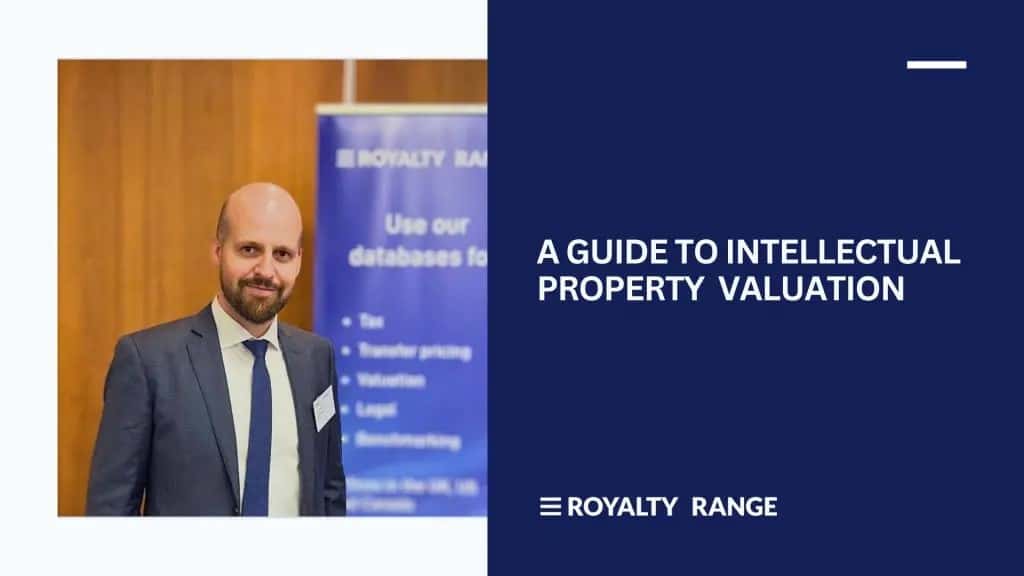A guide to intellectual property (IP) valuation

Lukas Balciunas |
September 15, 2023

Intellectual property (IP) can be a complex topic, but one that’s ultimately well worth getting to grips with. For example, if you’re looking to buy, sell, or license IP assets, or preparing for a merger or acquisition, an understanding of the area can help you to value the assets more accurately.
In this guide, we’ll cover what IP is, why accurate valuation is necessary, and the different ways to value IP depending on your situation. We also offer some info on our RoyaltyRange database and how the market data within is one of the best resources for realistic comparables that meet current regulations.
You can read this article for a complete guide to intellectual property and transfer pricing.
What is intellectual property?
The UK’s HMRC defines intellectual property as: “something that you create using your mind – for example, a story, an invention, an artistic work or a symbol.” Being ‘intellectual’ property, the assets in question are the ideas, knowledge, and creativity that go into making a product, rather than the physical end product itself. ‘Intellectual property’ can also refer to the legal protections given to these intangible assets that prevent others from using (and potentially damaging) them.
There are four types of intellectual property that can be protected by law:
- Patents
- Trademarks
- Copyright
- Trade secrets
Owning intellectual property is incredibly beneficial for businesses, as it’s what sets them apart from their competitors. IP can also be very valuable should a company decide to sell or license it.
Why is accurate intellectual property valuation necessary?
While there may have been a time when only an organization’s tangible assets were considered of any value, changes in the global economy over the years have seen the emergence of business models that put much more importance on IP as a measurement of value and potential growth. As it stands today, some businesses’ intangible assets may be far more valuable than their tangible ones. As a result, modern accounting practices include intellectual property value as part of transactions such as company mergers or acquisitions. Because of their value, IP can also be sold, licensed, or franchised in its own right.
Valuation of intellectual property is also useful for:
- Securing financing
IP can be used as collateral to obtain financing. This is more likely to be successful if the IP can be valued separately from the business in question. It’s also important to show that the IP assets will remain valid for the duration of the financing repayment period, and that they will remain marketable in the event of bankruptcy or foreclosure.
- Attracting partners
Before venture capitalists can invest in a company, they need to know the value of the company’s intellectual property. By having intellectual property valued accurately, the likelihood of winning over potential partners increases exponentially. In the case of joint ventures, strategic alliances, or mergers and acquisitions, valuations can give those involved an understanding of how much value the IP assets of all parties bring to the table.
- Settling disputes
When an IP asset is infringed upon, knowing its value can help to decide which legal route to pursue. For example, for a high value intellectual property, taking proceedings to court might be the most appropriate course of action. If not, a business can opt for an alternative dispute resolution, such as offering to license or franchise it to the infringing party. Having an accurate valuation can also help to calculate any damages incurred.
How to value intellectual property
When calculating the value of IP assets or rights, there are three main methods you can use: the market-based method, the cost-based method, and the income-based method. Below is a brief overview of all three, as well as some examples of use cases.
1.Market-based method
To apply a market-based method, you need access to data on similar IP assets being transacted. This method is recommended for asset purchase deals, corporate disputes, tax defenses, and business purchases/sales. While it’s more straightforward and direct than other methods, all data used must meet strict comparability criteria, hence this method may be difficult to apply for IP valuation.
2.Cost-based method
Cost-based methods involve calculating the costs of creating and developing an IP asset, including factors such as machinery, labor, legal protection, and other overheads. It can be based on the historical costs incurred, or the costs if a similar IP asset were to be recreated at present. This method may be applied during patent valuations, portfolio valuations, mergers and acquisitions, while seeking investment, or when licensing IP. It’s very easy to access the relevant internal data necessary, but this method doesn’t take into account the future value or market potential of the IP.
3.Income-based method
Income-based methods involve estimating potential future revenue, risks, and costs of the IP. Using these, you can calculate the IP’s net present value (NPV), which will either be positive or negative. There are several different income-based methods including discounted cash flow (DCF), capitalization of earnings, and relief from royalty. They can be used for selling/buying a business or licensing an IP asset. These methods are flexible to different types of IP at different stages of development. Although the income-based methods are generally more complicated to carry out, relief from royalties is the most commonly applied method for IP valuation. Specialist databases like the ones we offer at RoyaltyRange can help you provide reliable comparables for relief from royalty method.
Everything you need to know to value IP accurately
RoyaltyRange has a comprehensive database of up-to-date comparables that can be invaluable to anyone valuing intellectual property.
With our One Search service, you can receive data for a one-off search whenever you require, with no subscription necessary. Afterwards, you’ll receive a full report of the licensing agreements that meet your criteria, giving you everything you need to make an accurate valuation.
Get in touch to request a live demo or trial access, or if you’d like to go ahead, simply enter your search criteria in the One Search form.
Sources:
https://www.royaltyrange.com/home/blog/what-is-ip-valuation
https://www.royaltyrange.com/home/blog/ip-valuation-methods
https://www.wipo.int/sme/en/ip-valuation.html
https://www.valentiam.com/newsandinsights/ip-valuation
The information provided below is for general informational purposes only and should not be construed as legal or tax advice. It is not a substitute for consulting with a qualified legal or tax professional.
Request One Search
We will perform the search and deliver the initial results within hours, at no cost.




